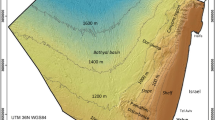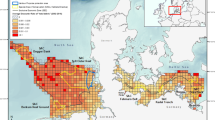Abstract
Monitoring of marine debris (also known as marine litter) is an essential step in the process to eradicate ecological dangers in marine ecosystems caused by humans. This study examines marine debris in the Caribbean country of Belize using geographic information systems (GIS) to develop (1) a detailed data library for use on handheld Global Positioning System (GPS) units and tablets with mobile mapping applications for deployment in the field and (2) a freely available, online mapping portal to share data with Belizeans to encourage future citizen science efforts. Four diverse communities were targeted ranging from larger more populated towns, to smaller villages across central and southern Belize: San Pedro, Caye Caulker, Punta Gorda, and Monkey River. Fieldwork was conducted over 1 month, during which data points were collected in 50-m surveys followed by debris cleanup and removal. Features in our database included material, quantity, item, brand, and condition. Over 6000 pieces of debris were recorded in GIS for further analysis, and 299 gal of debris were removed from the shores of Belize. The most abundant form of debris observed was plastic (commonly bottles) across all locations; plastic comprised 77.6 % of all debris items observed. Through GIS, a detailed snapshot understanding of debris patterns across multiple settings in Belize was documented. Ongoing collaborations with local organizations in Belize have demonstrated significant interest and utility for such GIS approaches in analyzing and managing marine debris. The data, methodology, visual representations, and online mapping platform resulting from this research are a first step in directly supporting local Belizean community advocacy and policy, while contributing to larger institutional strategies for addressing marine debris issues in the Caribbean.








Similar content being viewed by others
References
Aswani, S., & Lauer, M. (2006). Incorporating fishermen’s local knowledge and behavior into geographical information systems (GIS) for designing marine protected areas in Oceania. Human Organization, 65(1), 81–102.
Boyle, L. (2015). “Plastic pollution: a social justice perspective.” The Huffington Post. (accessed June 23, 2015).
Cheshire, A., Adler, E., Barbière, J., Cohen, Y., Evans, S., Jarayabhand, S., Jeftic, L., Jung, R.T., Kinsey, S., Kusui, E.T., Lavine, I., Manyara, P., Oosterbaan, L., Pereira, M.A., Sheavly, S., Tkalin, A., Aradarajan, S., Wenneker, B., & Westphalen, G. (2009). UNEP/IOC Guidelines on Survey and Monitoring of Marine Litter. Regional Seas Reports and Studies No. 186. IOC Technical Series No. 83. p. 1–131.
Cho, L. (2005). Marine protected areas: a tool for integrated coastal management in Belize. Ocean & Coastal Management, 48, 932–947.
Clean up the world. (2016). Clean Up the World: Aldebaran. http://activities.cleanuptheworld.org/?6776. Accessed 6 Jul 2016.
Coe, J. M., & Rogers, D. (Eds.). (1997). Marine debris: sources, impacts, and solutions. Springer Science & Business Media. 432 p.
Cunningham, D. J., & Wilson, S. P. (2003). Marine debris on beaches of the Greater Sydney Region. Journal of Coastal Research, 421–430.
Department of Environment (2008) "National plan of action for the control of land-based sources of marine pollution in Belize" Department of Environment Ministry of Natural Resources and the Environment. 66 p.
Derraik, J. G. (2002). The pollution of the marine environment by plastic debris: a review. Marine Pollution Bulletin, 44(9), 842–852.
Edyvane, K. S., Dalgetty, A., Hone, P. W., Higham, J. S., & Wace, N. M. (2004). Long-term marine litter monitoring in the remote great Australian bight, South Australia. Marine Pollution Bulletin, 48(11), 1060–1075.
EPA. Water: Marine Debris. National Marine Debris Monitoring Program. http://water.epa.gov/type/oceb/marinedebris/nmdmp.cfm (accessed December 27, 2014).
Gall, S. C., & Thompson, R. C. (2015). The impact of debris on marine life. Marine Pollution Bulletin, 92(1), 170–179.
Gregory, M. R., & Ryan, P. G. (1997). Pelagic plastics and other seaborne persistent synthetic debris: a review of Southern Hemisphere perspectives. In Marine Debris (pp. 49–66). Springer New York.
Hello Ocean. (2015). http://helloocean.org/. Accessed 28 Sept 2015.
Hetherington, J., Leous, J., Anziano, J., Brockett, D., Cherson, A., Dean, E., Dillon, J., Johnson, T., Littman, M., Lukehart, N. Ombac, J., & Reilly, K. (2005). The Marine Debris Research, Prevention and Reduction Act: a policy analysis. Columbia Univ. 42 p.
International Marine Debris Conference (2011). “Fifth International Marine Debris Conference Waves of Change: Global Lessons to Inspire Local Action.” International Marine Debris Conference. (accessed June 23, 2015).
Invitado, A. (2014). Belize shows the Caribbean how to better manage waste products—Caribbean DevTrends. http://blogs.iadb.org/caribbean-dev-trends/2014/04/11/belize-shows-caribbean-better-manage-waste-products/. Accessed 6 Jul 2016)
Ivar do Sul, J. A., & Costa, M. F. (2007). Marine debris review for latin America and the wider Caribbean region: from the 1970s until now, and where do we go from here? Marine Pollution Bulletin, 54, 1087–1104.
Jambeck, J.R. (2007). NOAA Restoration Center OMB Approval No. Community-based Restoration Program (CRP). NOAA. 1–238.
Jambeck, J., and Johnsen, K. (2015). Marine debris tracker: citizen-based litter and marine debris data collection and mapping. Computing in Science and Engineering, 17(4), 20–26.
Jambeck, J. R., Damiano, L., Magdol, Z., Merten, A., & Kennedy, J. (2007). A systematic approach to marine debris reduction efforts and education in New Hampshire (pp. 1–10). IEEE.
Jambeck, J. R., Geyer, R., Wilcox, C., Siegler, T. R., Perryman, M., Andrady, A., Narayan, R., & Law, K. L. (2015). Plastic waste inputs from land into the ocean. Science, 347(6223), 768–771.
Jang, S. W., Park, J. M., & Yoon, H. J. (2010). Monitoring and spatial analysis of marine debris by RS and GIS. Proceedings of the Asian Association on Remote Sensing, p. 1–7.
Jędrzejczak, M. F. (2004). The modern tourist’s perception of the beach: is the sandy beach a place of conflict between tourism and biodiversity? Coastline Reports, 2, 109–119.
Key, C., & Pillai, V. K. (2007). Tourism and ethnicity in belize: a qualitative study. International Review of Modern Sociology, 129–150.
Kusui, T., & Noda, M. (2003). International survey on the distribution of stranded and buried litter on beaches along the sea of Japan. Marine Pollution Bulletin, 47(1), 175–179.
Liu, T. K., Wang, M. W., & Chen, P. (2013). Influence of waste management policy on the characteristics of beach litter in Kaohsiung, Taiwan. Marine Pollution Bulletin, 72(1), 99–106.
Lu, M., Chernaik, M., & Weiskel, H. (2013). Ocean waste in the Gulf of Honduras: where it goes and what to do about it. eLAW Journal, 1–24.
Mace, T. H. (2012). At-sea detection of marine debris: overview of technologies, processes, issues, and options. Marine Pollution Bulletin, 65(1), 23–27.
Mark, D. M. (2000). Geographic information science: critical issues in an emerging cross-disciplinary research domain. URISA-Washington DC, 12(1), 45–54.
Martens, J., & Huntington, B. E. (2012). Creating a GIS-based model of marine debris “hot spots” to improve efficiency of a lobster trap debris removal program. Marine Pollution Bulletin, 64(5), 949–955.
Martin, J. M. (2013). Marine debris removal: one year of effort by the Georgia Sea Turtle-Center-Marine Debris Initiative. Marine Pollution Bulletin, 74(1), 165–169.
McDermid, K. J., & McMullen, T. L. (2004). Quantitative analysis of small-plastic debris on beaches in the Hawaiian archipelago. Marine Pollution Bulletin, 48(7), 790–794.
McMinn, S. (1998). Tourist typology observations from Belize. Annals of Tourism Research, 25(3), 675–699.
Monterey County Weekly. (2013) Putting marine debris on the map. Citizen scientists tap GIS technology for cleaner oceans. http://www.montereycountyweekly.com/news/local_news/citizen-scientists-tap-gis-technology-for-cleaner-oceans/article_8e354a37-91bb-522d-b01e-69a35cd47ebe.html (accessed January 17, 2015).
National Research Council (2008). Tackling marine debris in the 21st Century. National Academis Press, p. 218.
NOAA. Marine Debris n.d. (2014). http://marinedebris.noaa.gov/our-work (accessed December 26, 2014).
Ocean Conservancy. (2014a) Volunteer Ocean Trash Data Form. http://www.oceanconservancy.org/our-work/international-coastal-cleanup/data-form.pdf (accessed May 4, 2014).
Ocean Conservancy. (2014b) Turning the tide on trash: 2014 report. Ocean Conservancy. 1–26.
Ocean Conservancy. (2015) Trash free seas, every piece, every person: 2015 report. Ocean Conservancy. 1–24.
Oigman-Pszczol, S. S., & Creed, J. C. (2007). Quantification and classification of marine litter on beaches along Armação dos Búzios, Rio de Janeiro, Brazil. Journal of Coastal Research, 421–428.
Opfer, S., Arthur, C., & Lippiatt, S. (2012). NOAA Marine Debris Shoreline Survey Field Guide. US National Oceanic and Atmospheric Administration Marine Debris Program.
Pruter, A. T. (1987). Sources, quantities and distribution of persistent plastics in the marine environment. Marine Pollution Bulletin, 18(6), 305–310.
Ramos, A. (2014) “Be Green with the Belize Recycling Company—The San Pedro Sun News.” The San Pedro Sun News RSS. The San Pedro Sun, 2014. (accessed July 6, 2016).
Rees, G., & Pond, K. (1995). Marine litter monitoring programmes—a review of methods with special reference to national surveys. Marine Pollution Bulletin, 30(2), 103–108.
Ribic, C.A., Dixon, T.R., Vining, I., (1992). Marine debris survey manual. NOAA Technical Report NMFS 108. US Department of Commerce, Washington DC, p. 92.
Rosevelt, C., Los Huertos, M., Garza, C., & Nevins, H. M. (2013). Marine debris in Central California: quantifying type and abundance of beach litter in Monterey Bay, CA. Marine Pollution Bulletin, 71(1), 299–306.
Ryan, P. G., Moore, C. J., van Franeker, J. A., & Moloney, C. L. (2009). Monitoring the abundance of plastic debris in the marine environment. Philosophical Transactions of the Royal Society B: Biological Sciences, 364(1526), 1999–2012.
Santos, I. R., Friedrich, A. C., & Do Sul, J. A. I. (2009). Marine debris contamination along undeveloped tropical beaches from Northeast Brazil. Environmental Monitoring and Assessment, 148(1–4), 455–462.
Schlining, K., von Thun, S., Kuhnz, L., Schlining, B., Lundsten, L., Stout, N. J., Chaney, L., & Connor, J. (2013). Debris in the deep: using a 22-year video annotation database to survey marine litter in Monterey canyon, Central California, USA. Deep Sea Research Part I: Oceanographic Research Papers, 79, 96–105.
Schuurman, N. (2006). Formalization matters: critical GIS and ontology research. Annals of the Association of American Geographers, 96(4), 726–739.
Sheavly, S. B. (2007). National Marine Debris Monitoring Program: Final Program Report, Data Analysis & Summary. 76 p.
Sheavly, S. B. (2010). National Marine Debris Monitoring Program: Lessons Learned. Report to the US Environmental Protection Agency. 28 p.
Sheavly, S. B., & Register, K. M. (2007). Marine debris & plastics: environmental concerns, sources, impacts and solutions. Journal of Polymers and the Environment, 15(4), 301–305.
Slavin, C., Grage, A., & Campbell, M. L. (2012). Linking social drivers of marine debris with actual marine debris on beaches. Marine Pollution Bulletin, 64(8), 1580–1588.
Taffs, K. H., & Cullen, M. C. (2005). The distribution and abundance of beach debris on isolated beaches of northern new South Wales, Australia. Australasian Journal of Environmental Management, 12(4), 244–250.
Tim, U. S. (1995). The application of GIS in environmental health sciences: opportunities and limitations. Environmental Research, 71(2), 75–88.
Turner II, B. L. (1997). Spirals, bridges and tunnels: engaging human-environment perspectives in geography. Ecumene, 4(2), 196–217.
van Schagen, S., Fox, C., Wood, D., Vanze, G., (2013) Working for Clean Beaches and Clean Waters Report. Prepared for Ocean Conservancy. 1–15.
Velander, K., & Mocogni, M. (1999). Beach litter sampling strategies: is there a ‘best’method? Marine Pollution Bulletin, 38(12), 1134–1140.
Viehman, S., Vander Pluym, J. L., & Schellinger, J. (2011). Characterization of marine debris in North Carolina salt marshes. Marine Pollution Bulletin, 62(12), 2771–2779.
Watson, M. (2012). Marine Debris Along the Florida Keys Reef Tract-Mapping, Analysis and Perception Study. Open Access Thesis. Paper 330. University of Miami.
White, D., Cook, K., Hamilton, C., (2004) The net kit: a fishing net identification guide for Northern Australia. http://awsassets.wwf.org.au/downloads/mo001_the_net_kit_1dec02.pdf (accessed April 5, 2014).
Williams, A. T., Tudor, D. T., & Gregory, M. R. (2005). Marine debris-onshore, offshore, seafloor litter. In Encyclopedia of Coastal Science (pp. 623–628). Springer Netherlands.
Wright, D. J. (2013). The ocean GIS initiative: Esri’s commitment to understanding our oceans. ESRI., 2, 1–26.
Acknowledgments
This work would not have been possible without the financial support of the Department of Geosciences and Honors College at Georgia State University. In addition, the people of Belize were a daily resource for help and local knowledge. Special thanks to the time and attention given by Ilda Marin of the Caye Caulker Village Council, Leandra Cho-Ricketts of The Environmental Research Institute, Norman Budna of TIDE, and Joni Miller of Ocean Academy.
Author information
Authors and Affiliations
Corresponding author
Rights and permissions
About this article
Cite this article
Bennett-Martin, P., Visaggi, C.C. & Hawthorne, T.L. Mapping marine debris across coastal communities in Belize: developing a baseline for understanding the distribution of litter on beaches using geographic information systems. Environ Monit Assess 188, 557 (2016). https://doi.org/10.1007/s10661-016-5544-4
Received:
Accepted:
Published:
DOI: https://doi.org/10.1007/s10661-016-5544-4




